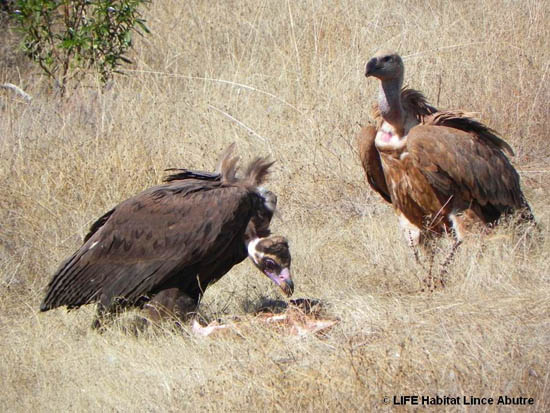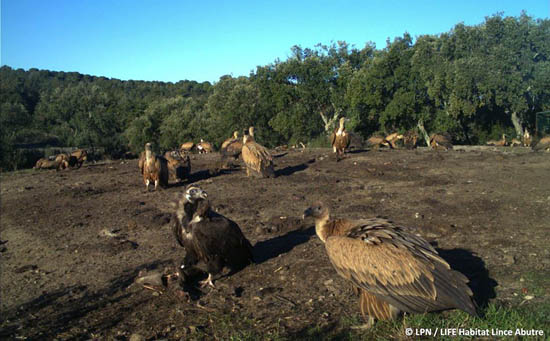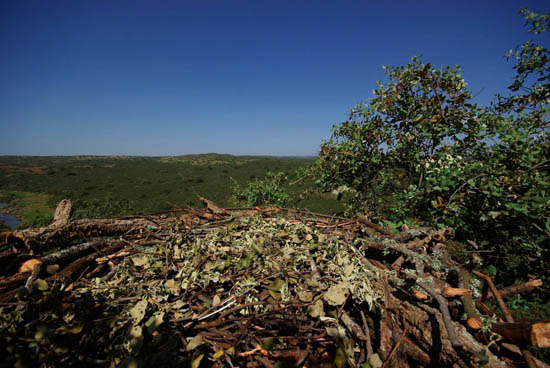 Two pairs of black vultures started nesting at Herdade da Contenda, in the municipality of Moura, in artificial nests installed by the LIFE project “Habitat Lince Abutre”. This could be the first step in reestablishing a breeding nucleus for this bird in Alentejo, after several decades without breeding in the region.
Two pairs of black vultures started nesting at Herdade da Contenda, in the municipality of Moura, in artificial nests installed by the LIFE project “Habitat Lince Abutre”. This could be the first step in reestablishing a breeding nucleus for this bird in Alentejo, after several decades without breeding in the region.
These two breeding pairs of black vulture were detected during the monitoring of artificial nesting platforms carried out by the League for Nature Protection (LPN) and following the conservation effort carried out by the LIFE project “Habitat Lince Vulture”, completed in September 2014.
LPN stresses that «the nesting of this Critically Endangered species in this region was possible as a result of the measures implemented under this project and the indispensable collaboration of Herdade da Contenda, Municipal Company (EM), as well as the proper management of the area promoted by this entity».
In a recent visit, «the installation of two pairs of black vulture was registered in two of the artificial nests implemented by this project in the municipality of Moura, and it was possible to confirm the presence of an example of this species in incubation in one of these nests and the deposition of coating material on another, thus corresponding to the beginning of the desired re-establishment of a breeding colony in Alentejo».
After more than forty years without confirmed breeding south of the Tagus River, in Portugal, during this period only one nesting attempt was registered (failed) about twenty years ago (also at Herdade da Contenda, in 1996), the occupation of these two artificial nests represents the «success of the implemented measures» under the LIFE project “Habitat Lince Vulture” and “an important milestone in the conservation of the black vulture in national territory”, stresses the LPN.
The Black Vulture returned as a breeder to Portugal in 2010 (in the Tejo Internacional region) and is currently nesting only in the Tejo Internacional (about 12 pairs) and Douro Internacional (1 pair), and this nesting may constitute the establishment of the third reproductive nucleus of the species in the country.

In early 2012, the LIFE-Nature project “Habitat Lince Vulture” installed 12 artificial nests for black vultures at Herdade da Contenda, out of a total of 30 installed in the regions of Moura, Mourão and Barrancos and the Vale do Guadiana, with to improve the conditions for the establishment and reproduction of this species.
This measure, as well as others carried out, is part of the Partnership Protocol established between this LIFE project and Herdade da Contenda.
In addition to these measures, a network of feeding fields for scavenger birds was also created in the project implementation area, aimed at the black vulture, as well as a broader set of conservation measures for the Iberian lynx and the habitats of these two species ( including awareness and involvement of local communities), in an investment of around 2.250.000 euros under the LIFE-Nature Programme.
Herdade da Contenda is owned by the Municipality of Moura and is managed by the municipal company Herdade da Contenda. Of recognized natural, scenic and hunting value, it corresponds to an area of fundamental importance in the conservation of the region's biodiversity.
For many years, the National Hunting Zone and Forest Perimeter, Herdade da Contenda has been an integral and essential part of the ecological balance of the Natura 2000 Network on the left bank of the Guadiana.
Over the next few months, the LPN will continue to monitor the nests occupied by the Black Vulture, in collaboration with Herdade da Contenda, «continuously bearing in mind the necessary compatibility with other activities underway on the property, such as hunting, forestry, ecotourism or usufruct by local communities».

Following the LIFE project “Habitat Lynx Vulture” and in collaboration with owners, managers, farmers and hunters, LPN hopes to “continue to contribute significantly to the conservation of the Black Vulture, the Iberian Lynx and the landscape that shelters them”.
The LIFE project “Promotion of the Habitat of the Iberian Lynx and the Black Vulture in the Southeast of Portugal” (acronym “Habitat Lince Vulture”) aimed to contribute to the improvement of the survival and reproduction conditions of the Iberian Lynx and the Black Vulture , two species classified as Critically Endangered and with important ecosystem functions in the Southeast of Portugal, also benefiting other endangered species.
This project was coordinated by LPN and had as beneficiaries several public and private institutions, namely the Center for the Study of Iberian Avifauna (CEAI), the National Association of Rural Owners, Hunting Management and Biodiversity (ANPC), the Association of Young Farmers of Moura (AJAM), the General Directorate of Food and Veterinary Medicine (DGAV), the Institute for the Conservation of Nature and Forests (ICNF) and the Research and Social Intervention Center (CIS / ISCTE-IUL). It also had Fauna & Flora International (FFI) and ICNF as co-financiers.
Running from January 2010 to September 2014, this project was 75% co-financed by the LIFE-Nature Program of the European Commission.


















Comments